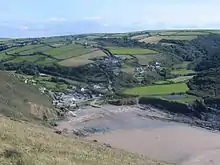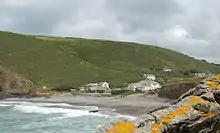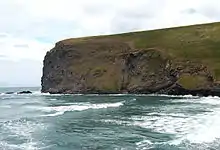Crackington Haven
Crackington Haven (Cornish: Porthkragen,[1] meaning "cove of the little crag") is a coastal village in Cornwall, England, United Kingdom. It is in the civil parish of St Gennys at grid reference SX140972 at the head of a cove on the Atlantic coast. The village is seven miles (11 km) south-southwest of Bude and four miles (7 km) north-northeast of Boscastle.[2]




Middle Crackington and Higher Crackington are associated settlements. They are situated on the hill southeast of Crackington Haven, half-a-mile and one mile distant respectively.
Geography
Crackington Haven is popular with tourists, walkers and geology students. The surrounding cliffs are well known for their visible folded sedimentary rock formations. The village gives its name to the Crackington formation, a sequence of Carboniferous sandstones and grey shales.[3]
The village has two café-style tea rooms, and a pub called the Coombe Barton Inn in a building which was originally the house of the manager of a local slate quarry.
Crackington Haven has a stony foreshore but a sandy beach is revealed at low water. There are toilet facilities near the beach and lifeguard cover in the summer.
Immediately north of the beach is Pencarrow Point and a few hundred yards south is Cambeak headland (between Tremoutha Haven and Cam Strand); the clifftop here is 328 ft.[4] Cambeak is derived from Old Cornish and means "crooked point".[5] One mile south of Crackington Haven, High Cliff rises to 735 feet (224 m) .[2] It is Cornwall's highest cliff, (Great Hangman in Devon has a cliff face of 820 feet (250 m).[6]
Crackington Haven lies within the Cornwall Area of Outstanding Natural Beauty (AONB). Almost a third of Cornwall has AONB designation, with the same status and protection as a National Park.
History
The manor of Crackington was recorded in the Domesday Book (1086) when it was one of several manors held by Berner from Robert, Count of Mortain. There was half a hide of land and land for 3 ploughs. There were 1 plough, 2 serfs, 6 smallholders, 4 acres of underwood, 20 acres of pasture, 4 cattle, 3 pigs and 25 sheep. The value of the manor was 10 shillings though it had formerly been worth £1 sterling.[7]
Until the nineteenth century, Crackington Haven was a small port similar to many others on the north coast of Cornwall. Limestone and coal were imported and slate and other local produce were exported. After the railways reached the district in 1893 the village could be reached more easily (from the North Cornwall Railway station at Otterham) so holidaymaking became more common.
Crackington Haven was badly affected in 2004 by the flood that damaged several other villages, including Boscastle in the flood of 2004.[8] The road bridge across the stream, several homes and pub were damaged by floodwater at this time.
References
- Place-names in the Standard Written Form (SWF) Archived May 15, 2013, at the Wayback Machine : List of place-names agreed by the MAGA Signage Panel Archived May 15, 2013, at the Wayback Machine. Cornish Language Partnership.
- Ordnance Survey: Landranger map sheet 190 Bude & Clovelly ISBN 978-0-319-23145-6
- "Archived copy" (PDF). Archived from the original (PDF) on 2008-12-04. Retrieved 2008-12-21.CS1 maint: archived copy as title (link) Dartmoor National Park Authority information sheet
- Richards, Mark (1974) Walking the North Cornwall Coastal Footpath. Gloucester: Thornhill Press; pp. 36-37
- Weatherhill, Craig (2009). A Concise Dictionary of Cornish Place-Names. Westport, Co. Mayo: Evertype. ISBN 9781904808220; p. 8
- Richards, Mark (1974) Walking the North Cornwall Coastal Footpath. Gloucester: Thornhill Press ISBN 0-904110-12-5; pp. 36-37
- Thorn, C. et al., ed. (1979) Cornwall. Chichester: Phillimore; entry 5,8,6
- "Crackington Haven". cornwall365.co.uk. Cornwall 365. Archived from the original on 22 January 2015. Retrieved 22 January 2015.
| Wikimedia Commons has media related to Crackington Haven. |